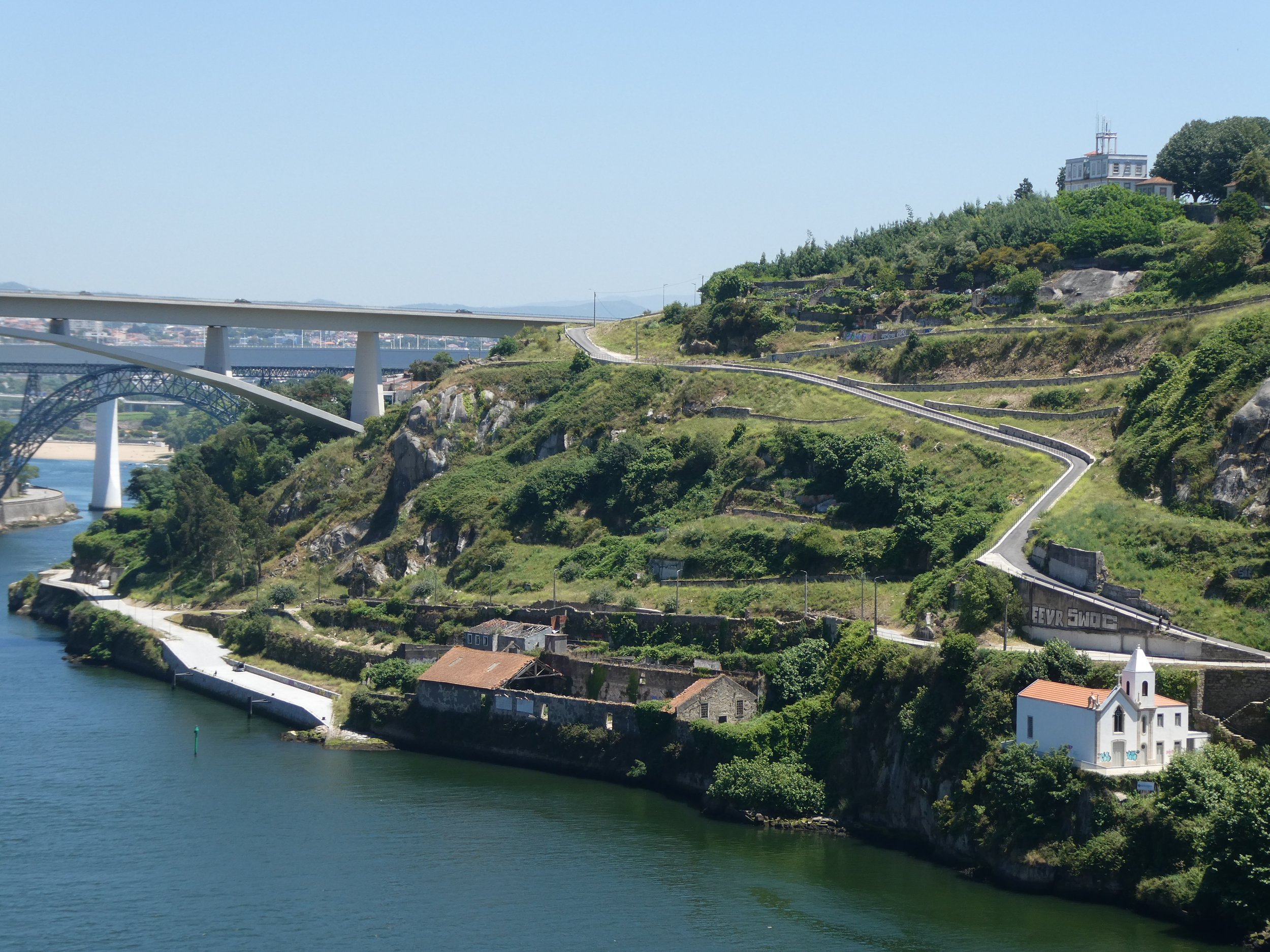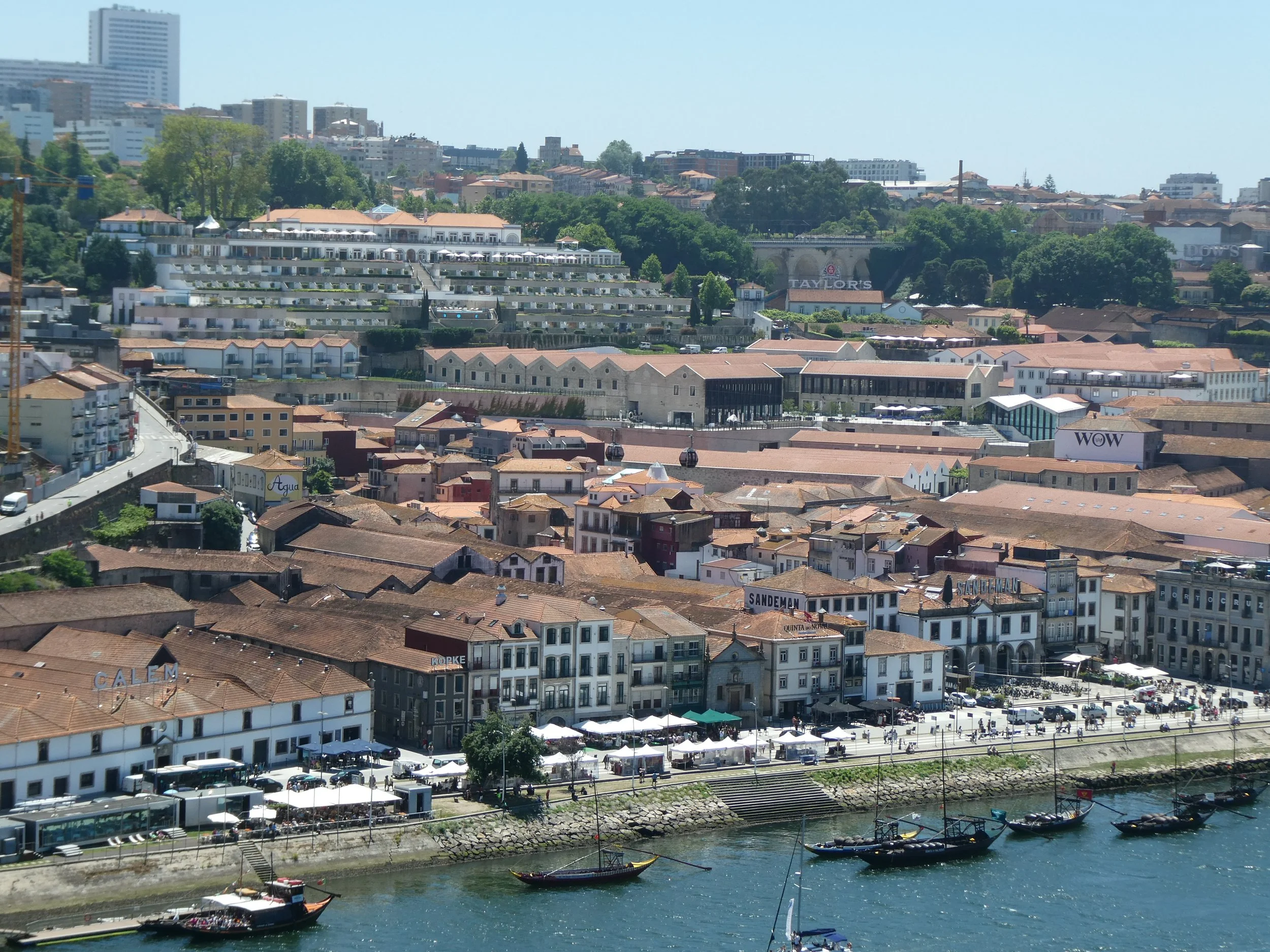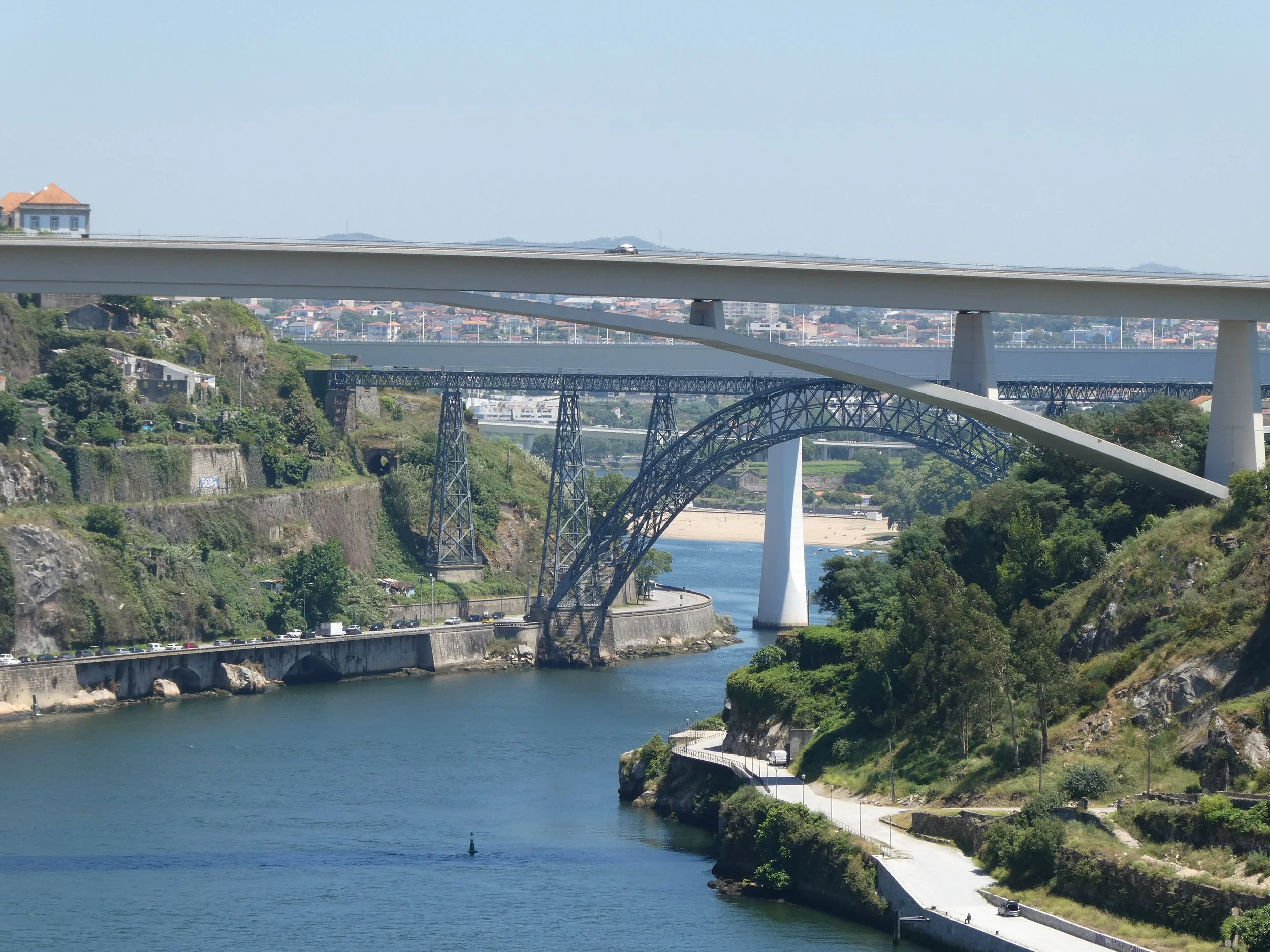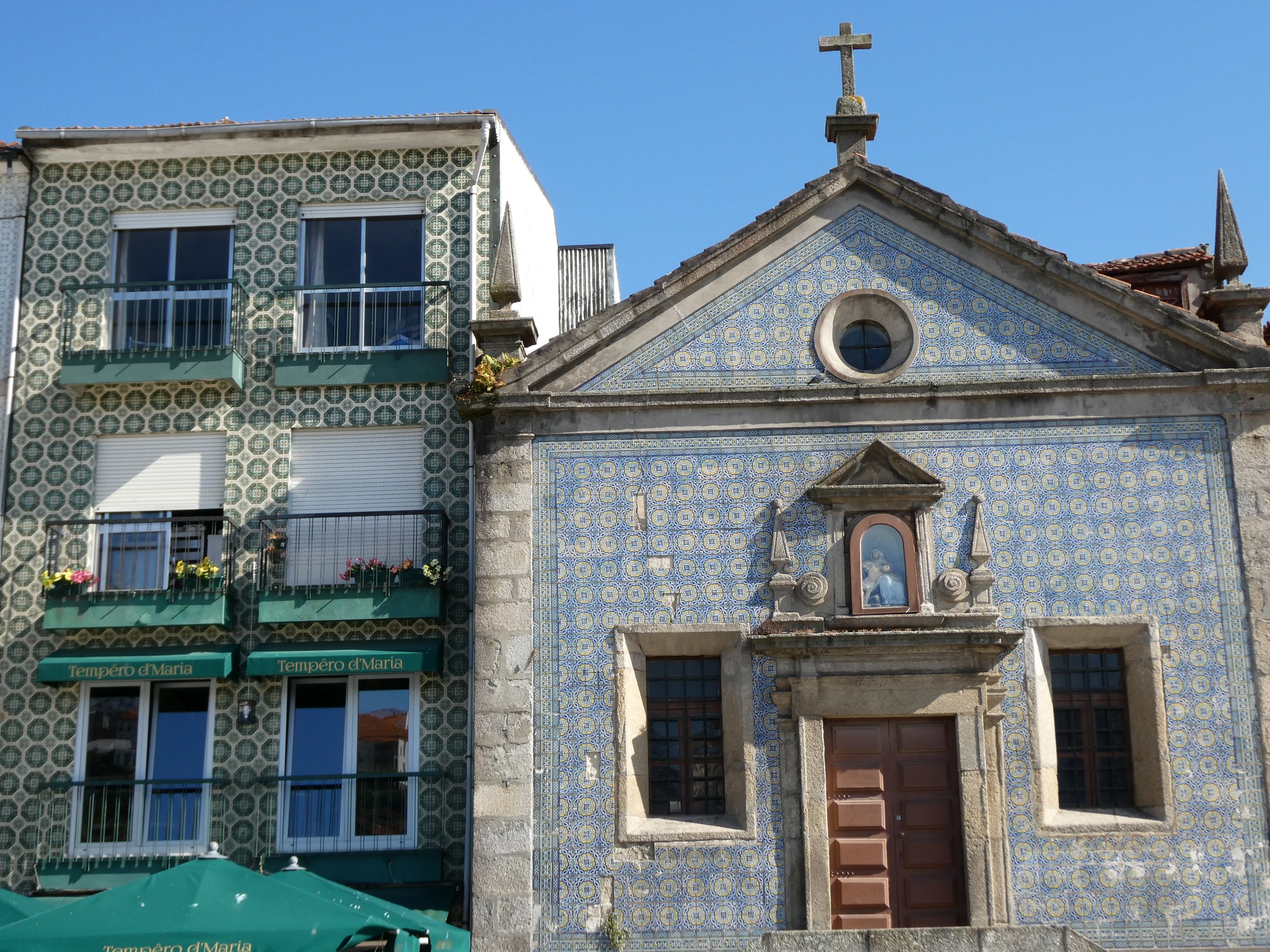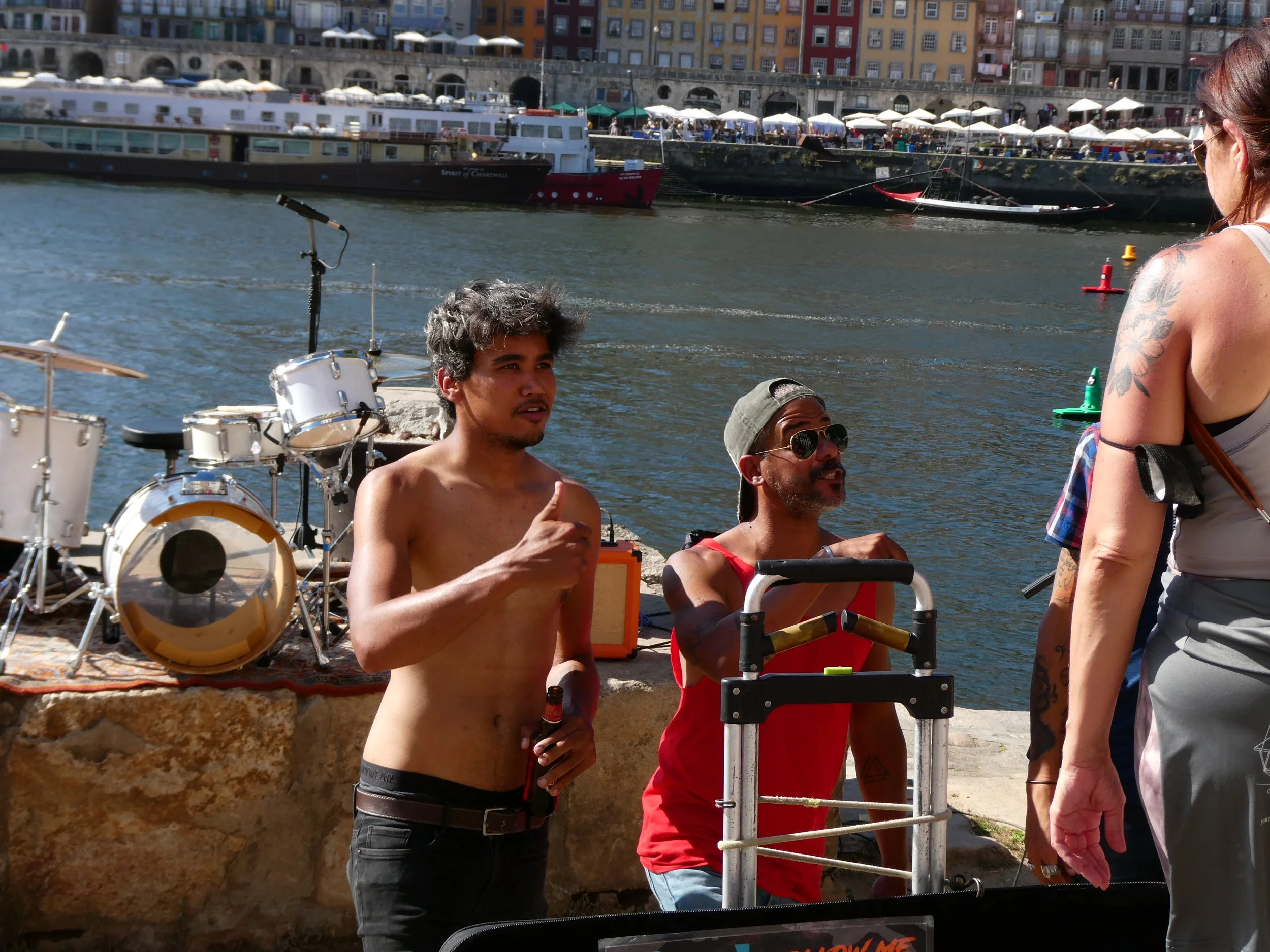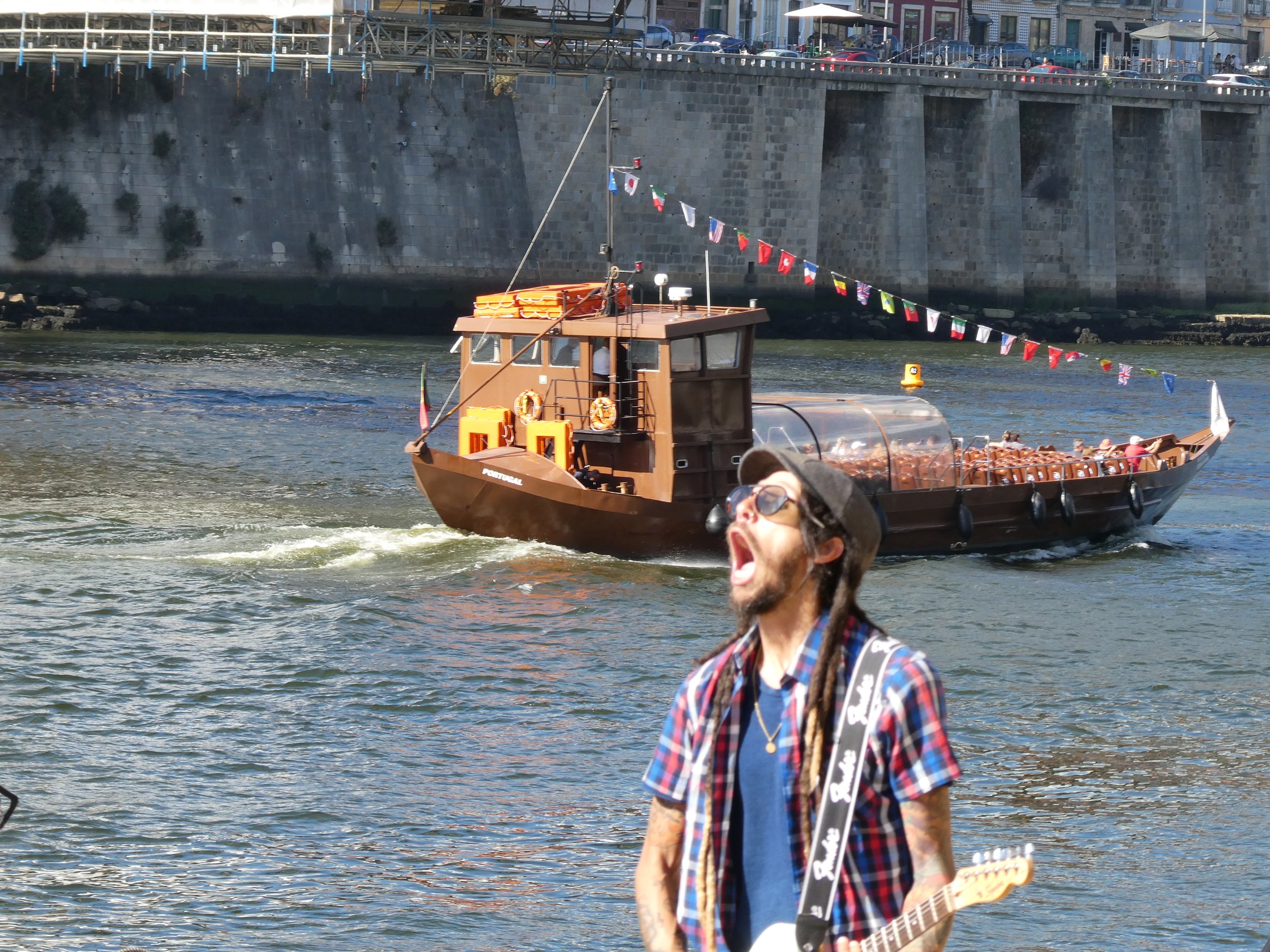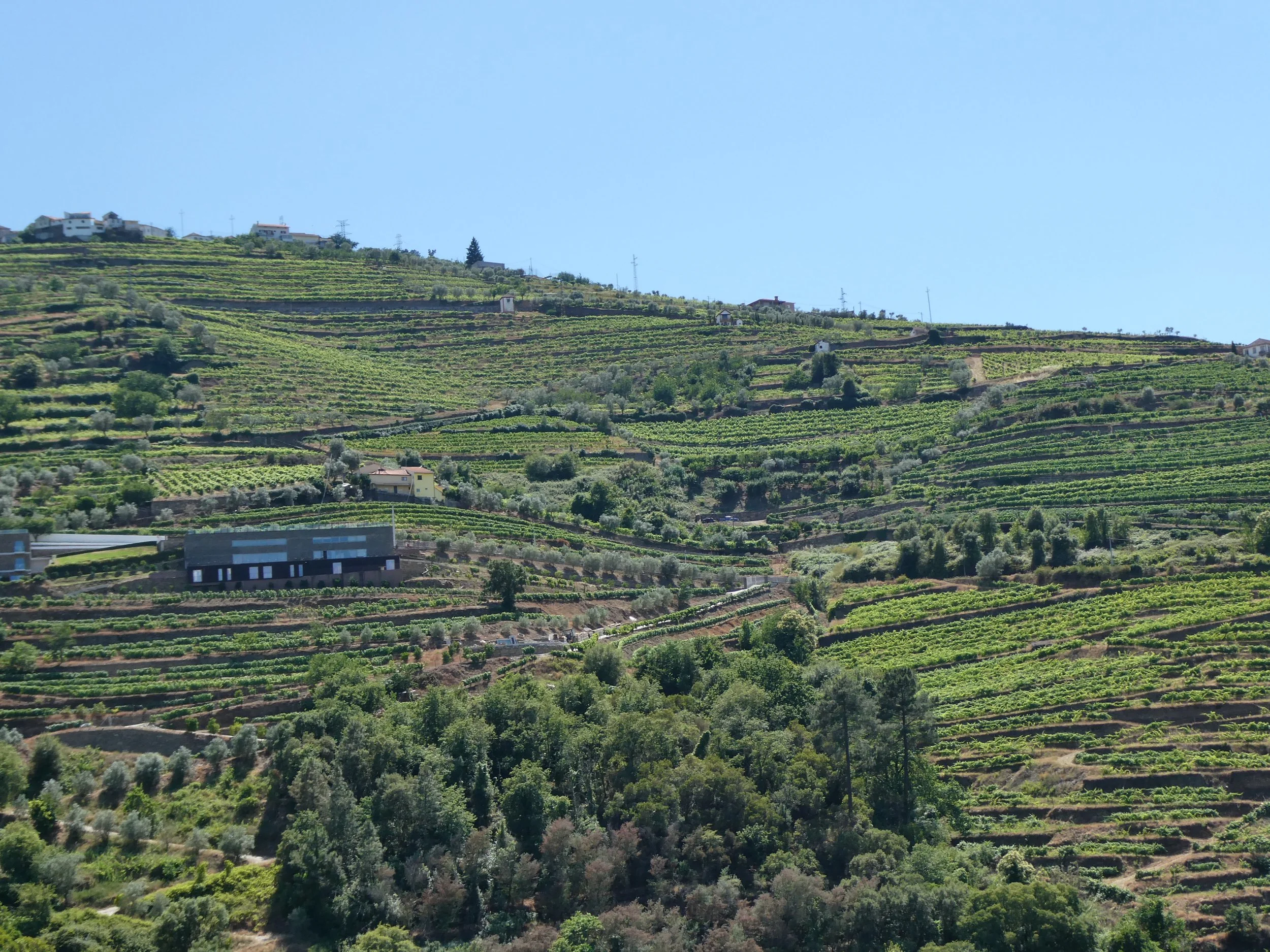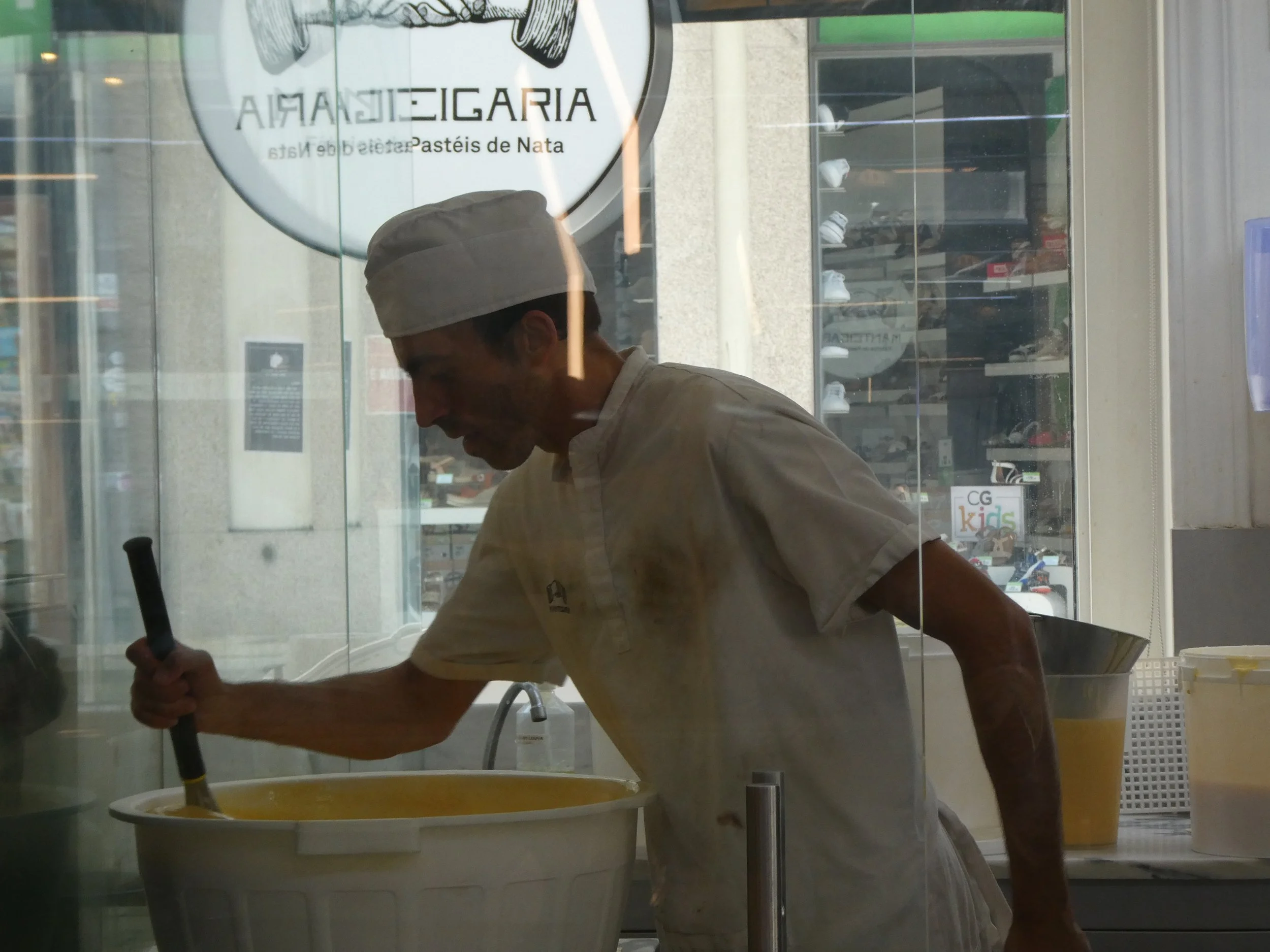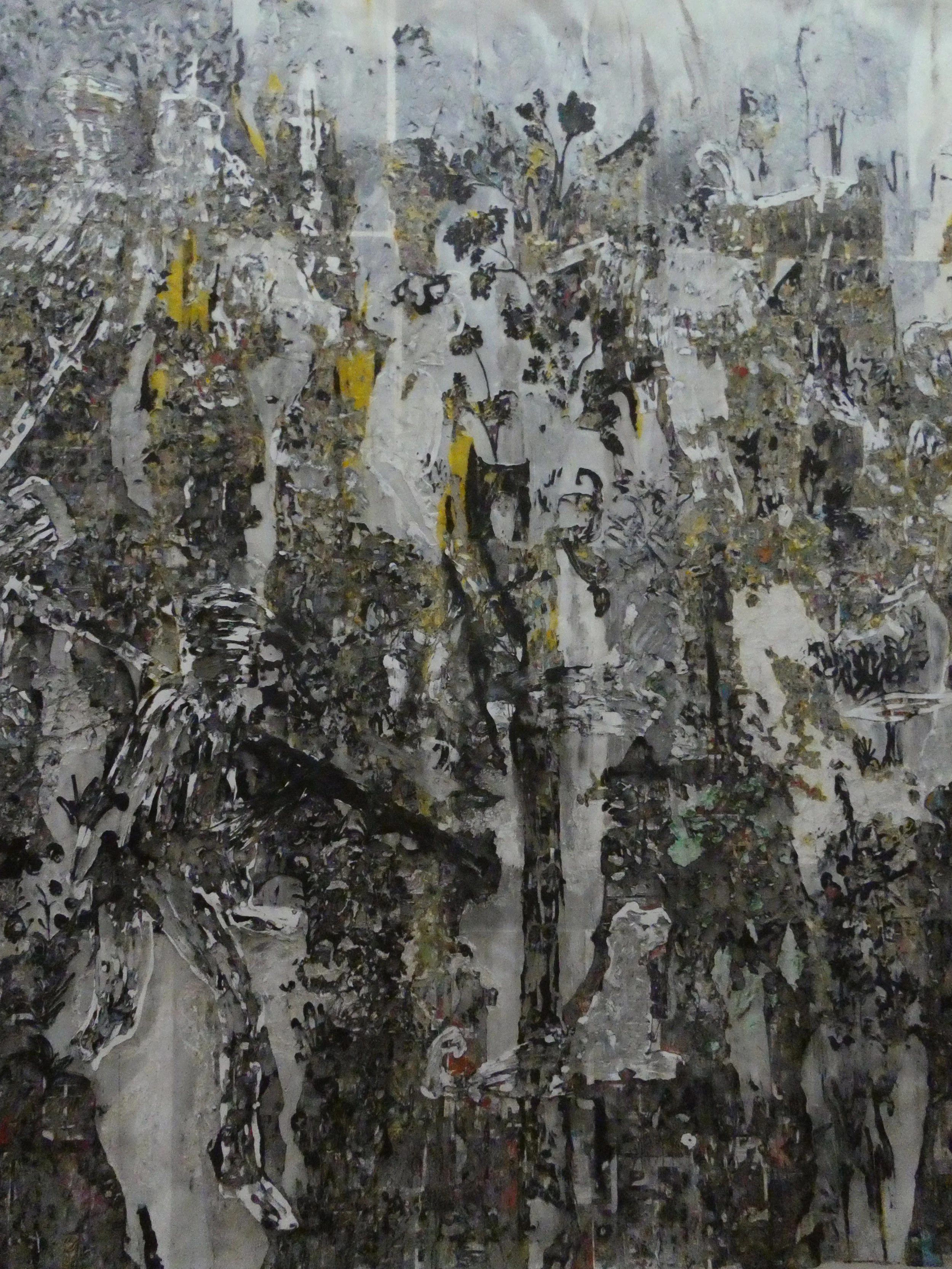Porto
The journey from Lisbon to Porto was not ideal — upon reaching the train station to buy our tickets, we were told that our train had been sold out, and would have to wait 4.5 hours for the next one. To pass the time, we snuck into a closed cinema that we found in a mall and sat in a dark theater until people began to file in the Benedict Cumberbatch Marvel movie came on. Highly disappointing. It was a rough day, I was lamenting my malnourishment of vegetables and excess of bread, cheese, and ham since arriving. Truly a massive excess. The streets in Porto are even more hilly than those of Lisbon, believe it or not, so our evening exploration around the city was not relaxing. However, lo and behold, we came upon a vegetarian buffet — something I have never even heard of — as if responding to my body’s grievances. The food was mediocre, but certainly acceptable.
For lunch we made our way to a little restaurant we had spotted the night before which had seemed like it would be satiating. Indeed, there was a line when we arrived before it opened, and we were the last to get a table. We tried some cod balls (fantastic) and some mixed-meat balls, a traditional dish of cod, grated potatoes, egg, and onion (sounds like a deconstructed fish-latke) and the famous francesinha, which is the country’s national sandwich, made with layers of meat, cheese, and wet bread, with a beer sauce.
Porto is absolutely beautiful. It possesses some of the rawness of Lisbon, but simultaneously a lot of the architecture is quite medieval. Big contrast between modern & industrial, and serene. The city lies on the Douro River, which stretches from the west coast east across the country. (Much more on the Douro River later.)
In the afternoon we walked to Villa Nova da Gaia, which is the area across the bridge with the wine “caves”, where much of the famous port wine is stored and aged. The grapes are grown in the Douro Valley. We found a casual wine tasting in one of these wineries, and got to see a brief tour of the facility. Port wine is, indeed, very sweet, not really to either of our liking, but on our way out we bought a bottle of the Dry White which we tasted and enjoyed.
Most of the barrels were 625 liters, and all had the dates in which the wines they held were processed. Since these barrels are susceptible to leakage, there are workers who jobs are to check up on the state of the barrels, and to repair any that are leaking. Since the barrels are carefully stacked, it is significant work to take one barrel out.
Because the Douro is so hilly, the grape harvesting is done almost exclusively by hand, whereas in most vineyards it is done by machine. It’s also very rocky, which gives many of the Douro wines their mineral-y taste.
(We had pregamed the tour and tasting with a bottle of “green wine” at lunch (indeed it tasted like young grapes — conspicuously tart — so we did not retain a good part of the information.)
Here’s a little exhibit of how white wine darkens with age, and red wine lightens.
The first three bottles starting from the left are whites, youngest to oldest, and the next six are reds, youngest to oldest.
Some cool guys on the walk back.
For some reason, we decided to have more bread, cheese, and meat for dinner, and we picked up some (very good) sheep cheese and prosciutto (and some cucumbers and tomatoes) on the way back to eat at the hostel.
Extending from Porto east across Portugal runs the Douro Valley, which is absolutely proliferated with vineyards, and the only region that grows the grapes used for port wine. We decided that the next day we would venture out to the valley, but instead of visiting a vineyard like the typical tourist does, we would camp out there. It really was a less impulsive decision than one might think. We boarded the 1:20PM train to get to Tua, which is about 2.5 hours east of the city.
The train ride was beautiful once the train got out of the small towns and ran along the river. There were patches of vineyards everywhere, even in the midst of land that looked otherwise untouched, and I got very excited when orange trees started appear all over as well. The scene was especially striking because everything was built on the valley, which for the most part was incredibly steep.
We were in one of those old trains that has no air conditioning, with big windows that slide down but periodically release and slam back up. Blue gel triangles that I had cut just a few hours ago were melding together from the heat.
I had brought my entire Osprey backpack and Logan brought a small backpack and tote bag, all aggregately filled with: two towels from the hostel, my special striped fabric/towel, four 1.5 liter bottles of water, my one liter Nalgene, Logan’s two half liter water bottles, four cans of sardines, a loaf of bread, digestives, a pack of ham, four oranges, two kiwis, a tomato, a cucumber, toothbrushes, toothpaste, Logan’s hair gel, some extra clothing, our bucket hats, and surely a few more things I cannot recall.
When we got off the train at Tua, Logan bought an ice cream thing from the touristy restaurant that sat right by the tracks. I separated the triangles that had melded together and dropped some, then found some orange trees and proceeded to pick a bunch, and Logan ate his ice cream and then dropped his triangles. Mine dissolved and then I ate the oranges I had picked, and his did not dissolve before he ate them. (If this is incomprehensible to you, move on, it’s okay.) I thought the oranges were repulsive. Logan was kind of indifferent. I was pretty upset about it.
We set off walking with no vision other than to find “someplace remote and with shade.”
We had to decide: by the river or up in the vineyards. The vineyards look majestic from far away when they are textured grids, but when we finally made our way up to one of them, we found it was really just a bunch of brambles. We climbed back down and finally settled on some rocks by the water. Much sweat. As far as I know the Douro River is not at all known to be a place for swimming, but it seemed perfectly conducive, so I proceeded to swim across. Pleasant, uneventful. The water started to feel more microscopic. Then I saw oranges on the trees that were directly in my trajectory. Splendid if they are better than the ones we tried before, serendipitous if they are not. I climb up. They are not better. I see larger ones closer to the trunk of the tree. I climb farther up the slope to reach them. These taste better. I hear Logan’s voice. Gosh, he swam incredibly quickly. I pick three more oranges and climb down closer to the shore to eat them, and see Logan in his yellow hat across the river. The phenomenon of sound in the valley was incredible. I eat the oranges incredibly methodically. Someone yelled through a blow horn, at me. No, it was a dog. I swim back.
I arrived and dried, we migrated to establish another town, at a picnic table. We ate some ham and bread. Uncharacteristic x2. We went back to our first establishment by the rocks and lay down on them, looking at the clouds. Logan was living in them. I accompanied him, though it wasn’t a novel experience for me. But something was novel: a kind of bereftness, hopefulness, hopelessness. Simple perfections can be eerie, foreboding, silent enough so that new tones of static manifest. The metronome started up. The bulbous ticks really did mimic the few moments of hot rain drops before they turn to downpour. Then I felt ticks on my limbs that were surely detached from my machine. A communal cascade.
We returned to the picnic table. We figured we might sleep on the dock that was in sight, so we established yet another town there. We set up our towels, ate digestives.
There was a party boat down the river? Must be. It must be close — this music is ridiculously loud, and it came from now where. It must be about midnight or 1AM. We are to go join. It was just light enough to walk without a flashlight — the moon was glaring — actually to go for a run. We try to avoid the dogs who are barking at us, hidden in the dark. We find the train tracks that we walked along to come from the station. The bridge is great to walk across in the dark. We follow the music, and no it is not a party boat, it is a gathering on a covered grassy area, mostly of elders. We approach, and realize that no one speaks English. We figure out it is an anniversary party. I try to play charades with two fishermen. They aren’t having it. Then we are welcomed in, and they give us cervezas, and proceed to give us meat and cheese and fig stuff from a large platter on toothpicks. They won’t stop giving them to us. They keep demonstrating in slow motion how to use the toothpicks to pick up the food. We understand how to spear food with toothpicks, we just want to stop eating. Their Portuguese sounded different from what we had been hearing in the cities. Communication was absolutely impossible — and they were not interested in creative kinds of interacting. At last we took our leave, walked back across the bridge, and down to our dock city. It could not have been more fitting.
Upon our return things had hit the fan. Bugs had seemed to gather for their own big celebration while we were gone — our dock city was invaded! The towels were not big enough to cover our expoed skin: various limbs, ankles, and our heads. Logan could not breathe because of the pollen. We didn’t sleep, and finally gave up and sat, staring east, waiting for the sun to come up, constantly swatting off bugs. It truly was almost torturous.
At last the sky turned lighter, though no conspicuous sun was in sight.
Looks can be deceiving.
Recovery is a process.
Process.
Goodbye, dock.
We packed up and crossed the bridge for the final time to get our 7:50 train.
At least Logan is getting his morning nutrients.
Logan: retired.
The wait was miserable, like being suspended in the no man’s land of a horror movie. What a miserable sensation; sleepless, bitten, congested, and completely down from the triangles. But something unfamiliar was glowing, too. Duality of sensation. What an afternoon —> night. The comfort of the train was luxury and we both slept. I’m not sure I’ve ever taken a longer shower.
I couldn’t sleep that afternoon — things were still numb and microscopic. I walked around the city, which was sweltering, and ate a sandwich with pork, cheese, and port wine soaked onions, and brought one back for Logan. Then we walked slowly, sat on some grass, freaked at every bug. I jolted when one of my head’s hairs poked my arm.
Despite our sensitivity and immense fatigue, we decided to go to our last night dinner reservation, which was at a “concept restaurant” called Emotivo. Indeed, it was the best thing we could have done for ourselves. Soon after we sat down, one of the chefs came to our table with a platter that held nine objects. We were to choose three between the two of us, each of which apparently represented one of two regions in Portugal. I chose a windmill and a little glass bottle of something clear, and Logan chose a figurine of a boy. 2/3 were the Algarve, which is the southern, beachy region, and so that was the region of inspiration for the dishes we would be served. I think that’s an awesome idea.
Fig and cheese salad with almonds. The textures and the cheese were especially great. Tuna, cured like prosciutto, with orange slices. Warm pea soup which I thought was divine. More tuna (unphotographed.) A stew with clams and three forms of pork: very tender cut, chorizo, and very fatty strips, all in a paprika + bacon base. Truly divine. Dessert was orange cake and carob brûlée. Our sense of rejuvenation was impeccable.
Our last day started with a trip to Manteigaria, a bakery which exclusively makes pasteis de nata, which are custard pastries/tarts, the national dessert of Portugal. We tried them at a few locations, in Lisbon, but once we came upon this one we had become hooked. (I forgot to include this important matter in the Lisbon post. Thank goodness they have locations in Porto, too. In one span of 60 hours in Lisbon, we each ate 11.)
Afterward, we took a bus to the Contemporary Museum of Porto, which turned out to be a gem. These pieces especially struck me, by an artist named Mark Bradford. Many of them were done during the start of Covid. He mainly uses everyday materials and tools from hardware stores, and experiences with different kinds of paper like billboards, film posters, comic books, and maps. Ancient mythology is a big source of inspiration for him.
Logan left in the afternoon, and so the woes of lone travel (or maybe just the tribulations of transportation) began…..




